No CrossRef data available.
Article contents
Creed and Culture: Jesuit Studies on Pope John Paul II edited by Joseph W. KoterskiSJ and John J. ConleySJ, Saint Joseph's University Press, Philadelphia PA, 2004, pp. xi+256, $35 hbk.
Review products
Creed and Culture: Jesuit Studies on Pope John Paul II edited by Joseph W. Koterski SJ and John J. Conley SJ, Saint Joseph's University Press, Philadelphia PA, 2004, pp. xi+256, $35 hbk.
Published online by Cambridge University Press: 01 January 2024
Abstract
An abstract is not available for this content so a preview has been provided. Please use the Get access link above for information on how to access this content.

- Type
- Reviews
- Information
- Copyright
- © The Author 2006 Journal compilation © The Dominican Council/Blackwell Publishing Ltd 2006


